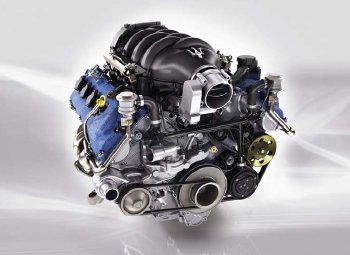|
There were challenges
to be faced by the new GranTurismo during its innovative creation. With
the new automatic gearbox, the auto-adaptive headlights and
the Skyhook suspension system, the Modenese company has
employed the most modern technology in order to provide
highest levels of comfort and performance.
The space
The coupé body
style is not an innovation. The
two-door, four-seat coupé is not new to the
automotive world, either, for Maserati was one
of the founders of the segment in 1946. But the
Maserati GranTurismo is the first modern coupé
that over-delivers on the visual promise of its
sensual body.
Inside the doors of the GranTurismo, you find
the space of a large, specialist four-seat sedan
inside the body of a stunning two-door coupé.
Like so much about this car, it offers the best of
both worlds, without compromising its strengths
to do it.
Almost half a metre longer than the Maserati
GranSport, it has delivered far more legroom
than the average in this class, plus almost a metre
of headroom. Maserati has achieved this by
stretching the distance between front and rear
wheels, then designing short overhangs at both
the front and the rear of the car to maintain its
design integrity. Normally, a wheelbase this long would be
found in a sedan, with much longer overhangs and at least
half a metre more overall
length.
The rear seats of a GranTurismo are also designed to be as
comfortable as the front seats even over cross-continental
journeys, and it has luxury four door
sedan touches like sculpted backrests and subtle lighting.
But it is not space alone that confirms the GranTurismo’s
interior as innovative. The cabin has been divided by a
long, crafted central tunnel that
feeds down from Maserati’s traditional dashboard vee and
continues through to the rear-seat armrest. This innovation
gives rear-seat users a sense
of their own, individual space.
Length and
Strength
Maserati shocked
the world with the unique
chassis-engineering theme in the breakthrough
Quattroporte, and the GranTurismo carries
over the stunning sedan’s rear-biased weight
distribution. It has achieved this by containing
the heaviest and most-critical components of the
car – the engine, the gearbox and the differential
– between the front and rear axles. This makes
the GranTurismo the only car in the class with
more than 51 percent of its weight over the rear
axle.
To understand why Maserati has gone to great
lengths to achieve this, even a brief study of
modern Formula One cars or Indy 500 winners
will explain it all. They all have more than 60
percent of their mass over the rear axle – and
even Maserati’s dominant MC12 FIA GT racing
car has this same trait. Having a rear-weight
bias gives the GranTurismo a handling, grip and
accident-avoidance capability similar to modern
racing cars.
Yet, having an ultra-long wheelbase, large wheels and the
option of the Skyhook Active ride system means the
GranTurismo does not accept racing car
compromises to its comfort, luxury and practicality to
achieve this on-road poise.
While the extra length in the wheelbase guaranteed Maserati
had the space to contain the engine behind the front-axle
line, it helped that the
GranTurismo had one of the most advanced high-performance
engines in the world. From just 4.2 litres, the GranTurismo
delivers a crushing 405hp.
Rivals from BMW and Mercedes-Benz, for example, have much
larger engines with considerably less power and, therefore,
less efficiency.
Its 285km/h top speed is considerably higher than its rivals
and it also out-sprints them from 0 to 100km/h (5.2
seconds). So, while it still dominates
its rivals on its power, this high-effi ciency engine
strategy also gave the GranTurismo an engine that is lighter
than the engines in rival coupés. This,
in turn, brought enormous benefi ts to the handling and
braking prowess of the GranTurismo, without compromising its
straight-line performance.
The GranTurismo’s engine is coupled to a highly-efficient
automatic transmission that sets new standards for
performance cars. This transmission is
capable of changing gear at up to 7200rpm, and no other
automatic transmission in the world is capable of working at
higher engine speeds.
Smooth Co-operator
Designing a car
to fulfil both the sports-car
traditions of Maserati and the luxury demanded
by a busy day-to-day life took clever thinking.
Most people would not suppose that the
GranTurismo’s automatic transmission and its
Skyhook active suspension system had a reason to
communicate.
One of them is a stunningly smooth
and fast gear shifter, capable of coping with
higher engine speeds than any other automatic
transmission in the world. The other normally
keeps the body riding smoothly by making more
than 100 decisions about the bumps in the road
every second, then instantly altering the stiffness
of the suspension to cope. Yet, while the well-proven transmission is one of
the smoothest in the world, Maserati’s engineers
use the Skyhook system to make the shifts even
smoother.
|
 |
|
If the standard six-speaker GranTurismo audio system
is a thing of wonder, then the optional Bose
Surround Sound system is a thing of awe. |
|
 |
|
From just 4.2 litres, the GranTurismo delivers a
crushing 405hp.
Rivals from BMW and Mercedes-Benz, for example, have much
larger engines with considerably less power and, therefore,
less efficiency. |
|
|
 |
|
With the new automatic gearbox, the auto-adaptive
headlights and the Skyhook suspension system, the
Modenese company has employed the most modern
technology. |
|
 |
|
Maserati shocked
the world with the unique
chassis-engineering theme in the breakthrough
Quattroporte, and the GranTurismo carries
over the stunning sedan’s rear-biased weight distribution. |
|
 |
|
|
The Skyhook system normally runs the car at its softest
possible setting, and then stiffens (and, of course,
subsequently re-softens) itself to deal with bumps as the
wheels roll over them. However, because the sensory data for
the Skyhook system and the transmission system end up in the
same place, Maserati’s engineers linked the two systems
together. The GranTurismo now slightly changes its
suspension settings so that the driver
feels even less body movement during a gearshift.
But that’s not all it does. Drive with a more sporting
intent by pushing the Sport button, and the computers will
presume you want to feel more
intimately involved in what the car is doing. The gearshift
computer will cut 40 percent from the gearshift times, so
they are sharper and more
urgent. The Skyhook will change its philosophy from supreme
ride control to supreme body control, to give you better
handling and grip. And,
together, they conspire to give a more precise, crisp feel
inside the cabin every time you change gear.
Cornering the light market
No other car maker knows more about LED
lighting than Maserati. The 3200GT was the first
production car in the world to use Light Emitting
Diodes (in its famous Boomerang tail lights) and
Maserati has built a wealth of LED knowledge
since then. This knowledge has culminated
in the stunning new rear light design on the
GranTurismo.
Each light assembly uses 96 LEDs. Some of them
are running lights, some are stop lights and
others are used just as turn indicators. The beauty
of LEDs is that they illuminate faster and more
intensely than conventional bulbs, last longer
and use less energy to run as well. While there
are seven separate parts in each taillight, another
advantage is that nobody will never mistake a
GranTurismo in traffic at night. Even from half
a mile away, the taillights make it as much of a
stand-out performer at night as its Pininfarina
body design makes it during the day.
But Maserati’s mastery of lighting does not stop at the
GranTurismo’s shapely tail. The GranTurismo also introduces
Adaptive Light Control to
Maserati. The car’s bi-Xenon lights not only project a
brighter, whiter beam than conventional headlights, but they
are automatically self-adjusting
as well.
The lights, though, do not just adjust for height. They are
linked (electronically) with the rest of the car’s systems
and its computer calculates the
car’s speed and its steering angle. When the car is turning
at night, the Adaptive Light control swivels the bi-Xenon
high- and low-beam unit up to
15 degrees, so GranTurismo drivers can always see what they
are turning towards. For safety reasons, the system returns
to a conventional, fixed
state at speeds above 120km/h. But, unlike LEDs, bi-Xenon
lights need to warm up before they are at their most
effective, which means they are not
terribly effective if you want to fl ash your lights on the
motorway. So the GranTurismo’s finely detailed headlight
also contains a conventional light,
called Flash to Pass, to provide lighting during the day if
the bi-Xenon lights are switched off.
The Music Store
If the standard six-speaker GranTurismo audio
system is a thing of wonder, then the optional
Bose Surround Sound system is a thing of awe.
It is not just the number of speakers involved,
but where Maserati has located them, the exotic
materials they use and even their priority in the
GranTurismo’s engineering plans.
This sound system was designed into the car from
its inception. Obviously, it was a core part of the
early discussions on the interior luxury, but it was
on the agenda from the earliest engineering and
weight distribution discussions as well.
Maserati has long believed that flagship audio
quality should be designed in to a car from the
start – and the quality of the Quattroporte’s
audio is evidence enough!
So the Bose Surround Sound system demanded
11 speakers to provide the perfect balance
and quality of sound for every occupant of the
GranTurismo. Bose developed special Neodymium
iron-boron magnets for the GranTurismo’s speakers, with 10
times the energy density of conventional speaker magnets.
These high-performance speakers deliver far better acoustic
performance than conventional speakers while being far
smaller and far lighter as well.
While engineers always strive for lighter weight to help
with acceleration, braking, handling and even fuel economy,
having smaller speakers also
helps to maximize space inside the cabin. It also uses the
Bose AudioPilot Noise Compensation Circuitry, which subtly
adjusts the sound to compensate
for noises from outside the car or even from bumps and tyre
noise at higher speeds.
From the start of 2008, Maserati will also remove the need
for clumsy, fiddly CD stacker changes. Instead, the
GranTurismo will introduce an optional
USB port so music lovers can load more than 180 hours of
songs onto the GranTurismo audio system’s 30GB hard disc
drive as well.
|
|
|
|